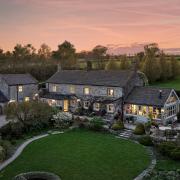Janette Sykes delves into the history of a South Yorkshire village popular with commuters who travel into Doncaster and Sheffield PHOTOGRAPHS BY BRIAN ROSS
EVEN on the glummest of winter days there's something cosy and cheerful about the South Yorkshire village of Tickhill. Maybe it's the mellow stone and brick of its many historic buildings and rustic cottages, its quaint narrow streets and cobbled pavements or the profusion of family-run shops and businesses lining its pretty main street. In any event, it's plain to see why some call it 'the jewel in Doncaster's crown', whatever the time of year.
Nowadays, it's a popular place to live, with commuters travelling to nearby Doncaster, Sheffield and beyond - and stretching back in time, it seems its transport links have always been key to its prosperity. Situated close to the border with Nottinghamshire, in the Middle Ages it was the second most prominent town in South Yorkshire after Doncaster - no doubt due to its location around the junction of two main roads, now the A631 and A60.
Now close to the busy A1(M), Tickhill was once on the route of the London to Glasgow mail coaches, plus coaches from Nottingham to Doncaster and Sheffield to Louth. These would stop at the former Red Lion, an 18th century coaching inn, now redeveloped as an upmarket shopping centre, St Mary's Court, which includes a wine bar, boutique and florist. The history of the village stretches back at least to the Norman Conquest, when William the Conqueror granted several manors in the north of England to Roger de Busli, one of his supporters from Normandy.
Its name is not listed in the Domesday Book, which refers to the Saxon settlement of Dadesley, or 'Daeddi's clearing', which is now on the northern edge of Tickhill. The name Tickhill is likely to have derived from the small sandstone hill upon which de Busli built his castle, which enjoyed an eventful history through the centuries.
Prince John commandeered it when his brother King Richard I returned from the Crusades in the late 12th century, it was the location of a three-week siege in the 14th century and was a local centre of resistance during the Civil War. These days it is a striking ruin, though is private property and not open to the public. However it still boasts its Norman gatehouse, which, along with its moat, can be seen from the road as you pass through the village. It also retains the foundations of its 11-sided keep, thought to be one of only two in the world, built in the 1170s.
Anyone interested in place names will be fascinated by the term 'wong' found in several areas of Tickhill, such as Church Wongs, North Wongs, South Wongs and Wong Lane. It is thought to derive from 'furlong', describing the narrow pieces of land worked by early farmers in line with communal rules and long-held customs. One of Tickhill's best-known features is its Buttercross, built in 1777 at the junction of the village's two main roads to revive its weekly market. Though the move failed to achieve its goal, it continues to remain a famous central landmark.
Local markets, however, are not a totally lost cause in modern times. Tickhill Country Market is held in the Methodist Church Lounge on Northgate every Friday morning between 10am and 11.45am, when discerning shoppers can choose from a wide selection of homemade cakes, savouries, preserves and plants and home-produced plants, garden items and eggs.
Also on Northgate is the striking 15th century former St. Leonard's Hospital, an excellent example of a medieval building constructed from timber and plaster. It is now used as the parish room for St. Mary's Parish Church as well as a meeting room for the Women's Institute. It was renovated in 2007. Anyone in search of a spot of peace and quiet should head off past the castle ruins to the oasis of calm that is the village Mill Pond, complete with corn mill and assorted wildfowl, including mallards and moorhens - a quiet and pleasant place for a stroll or to sit and relax in fine weather.
For those seeking more stimulating pursuits, Tickhill offers a lively social life, with a wealth of leisure activities and groups for all ages, ranging from Northgate Pre- School group and Tickhill Scouts and Guides to Tickhill Male Voice Choir and Les Francophiles de Tickhill, who conduct their meetings in English, but offer plenty of opportunities to speak French.
Regular live music is a popular draw at the Scarbrough (sic) Arms, which hosts regular folk nights, featuring folk, blues and country, and musicians' nights, showcasing both instruments and singers and spanning classical, popular and 1960s styles.
This commendable sense of community is also reflected in a recent initiative to raise enough money to renovate the tower, nave and aisle roofs and masonry of Tickhill's historic St Mary's Parish Church, which dominates the skyline. Originally built in the 12th century, when the village lay on a key trade route between north and south, its size and position reflects its importance. Further improvements were made in the late 1300s and early 1400s, when the tower was extended to a height of 120 feet, the interior was enhanced and the church's external appearance was modified to look much as it does today.
Thanks to grants from English Heritage, the Heritage Lottery Fund and Yorkshire Historic Churches Trust, plus the concerted efforts and generosity of local people, �203,000 was raised in just 19 months to launch the latest restoration project.Work is now well underway and is expected to be complete by the end of May.


























